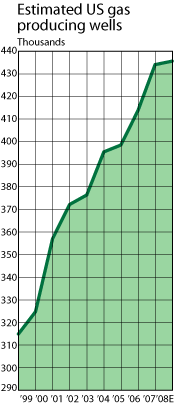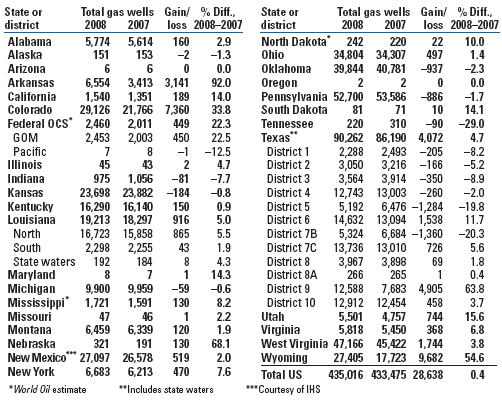In 2008, the number of new gas wells drilled rose a solid 44%, representing 28,638 new producers. The drilling activity produced a significant new well increase over 2007’s 19,845 new wells. However, the total number of US gas wells was essentially flat at just over 435,000 wells.
The largest new well gains came in four states: Wyoming (9,982), Colorado (7,360), Texas (4,072), Arkansas (3,141) and West Virginia (1,744). These states represent about 92% of the new producing gas wells. Producing gas well totals were maintained by steady development drilling in the expanding number of continuous resource plays. These plays are primarily in shale and coalbed methane with some tight gas sand drilling.
Texas maintained its No. 1 spot with more than 90,000 wells. However, half of the RRC districts showed declines. Districts with increasing totals were led by District 9, which gained over 4,900 new wells. These were drilled mainly for Barnett Shale gas. District 6 led the state in total gas wells with 14,632 producers, primarily in Henderson, Nacogdoches, Panola and Rusk counties, a traditional tight gas play in East Texas.
Pennsylvania continues in second place with more than 52,000 wells, many drilled for the Marcellus Shale. West Virginia continues in third place with more than 47,000 wells, another increase. CBM activity continues to develop gas from many shallow wells.

Oklahoma maintained its fourth position, but saw a minor drop in gas wells. Its total count is nearly 40,000 producers. The state has had strong activity in shale and CBM plays at either end of the state. Ohio held onto fifth place with more than 34,000 gas wells. The state gained wells this past year, adding almost 500 new producers.
Colorado displaced New Mexico for sixth place. Operators added more than 7,300 wells to lift the state total to more than 29,000 wells. Wyoming followed in seventh place, adding more than 9,600 wells. It now has more than 27,000 active producers. The mountain states continue to struggle with water disposal problems.
New Mexico moderated its drilling, dropping to eighth place. More than 500 new wells were added, bringing its total to more than 27,000. In the 2007 review, we noted a decline of drilling intensity, which was realized in the 2008 data.
| Estimated US wells producing gas at the end of 2008 |
 |
|
Kansas dropped to ninth position with a minor loss of productive wells. Its total number is still more than 23,000 wells. Louisiana dropped to tenth position, even though it had a net increase of more than 900 wells, which lifted its producer total to more than 19,000. Gas activity is strongest in the state’s northern half.
Although the industry has identified several new continuous resource plays (see World Oil, August 2008, p. 77), the questionable economic environment will limit development in 2009.
The Gulf of Mexico had a significant gain in percentage and total wells. The industry added 450 new gas producers, an 18% increase, which lifted the producer total to more than 2,400 wells.
|




